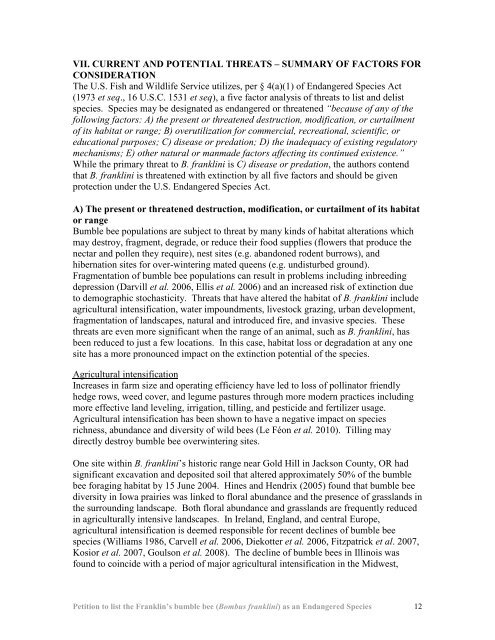Franklin's bumble bee - The Xerces Society
Franklin's bumble bee - The Xerces Society
Franklin's bumble bee - The Xerces Society
You also want an ePaper? Increase the reach of your titles
YUMPU automatically turns print PDFs into web optimized ePapers that Google loves.
VII. CURRENT AND POTENTIAL THREATS – SUMMARY OF FACTORS FOR<br />
CONSIDERATION<br />
<strong>The</strong> U.S. Fish and Wildlife Service utilizes, per § 4(a)(1) of Endangered Species Act<br />
(1973 et seq., 16 U.S.C. 1531 et seq), a five factor analysis of threats to list and delist<br />
species. Species may be designated as endangered or threatened “because of any of the<br />
following factors: A) the present or threatened destruction, modification, or curtailment<br />
of its habitat or range; B) overutilization for commercial, recreational, scientific, or<br />
educational purposes; C) disease or predation; D) the inadequacy of existing regulatory<br />
mechanisms; E) other natural or manmade factors affecting its continued existence.”<br />
While the primary threat to B. franklini is C) disease or predation, the authors contend<br />
that B. franklini is threatened with extinction by all five factors and should be given<br />
protection under the U.S. Endangered Species Act.<br />
A) <strong>The</strong> present or threatened destruction, modification, or curtailment of its habitat<br />
or range<br />
Bumble <strong>bee</strong> populations are subject to threat by many kinds of habitat alterations which<br />
may destroy, fragment, degrade, or reduce their food supplies (flowers that produce the<br />
nectar and pollen they require), nest sites (e.g. abandoned rodent burrows), and<br />
hibernation sites for over-wintering mated queens (e.g. undisturbed ground).<br />
Fragmentation of <strong>bumble</strong> <strong>bee</strong> populations can result in problems including inbreeding<br />
depression (Darvill et al. 2006, Ellis et al. 2006) and an increased risk of extinction due<br />
to demographic stochasticity. Threats that have altered the habitat of B. franklini include<br />
agricultural intensification, water impoundments, livestock grazing, urban development,<br />
fragmentation of landscapes, natural and introduced fire, and invasive species. <strong>The</strong>se<br />
threats are even more significant when the range of an animal, such as B. franklini, has<br />
<strong>bee</strong>n reduced to just a few locations. In this case, habitat loss or degradation at any one<br />
site has a more pronounced impact on the extinction potential of the species.<br />
Agricultural intensification<br />
Increases in farm size and operating efficiency have led to loss of pollinator friendly<br />
hedge rows, weed cover, and legume pastures through more modern practices including<br />
more effective land leveling, irrigation, tilling, and pesticide and fertilizer usage.<br />
Agricultural intensification has <strong>bee</strong>n shown to have a negative impact on species<br />
richness, abundance and diversity of wild <strong>bee</strong>s (Le Féon et al. 2010). Tilling may<br />
directly destroy <strong>bumble</strong> <strong>bee</strong> overwintering sites.<br />
One site within B. franklini’s historic range near Gold Hill in Jackson County, OR had<br />
significant excavation and deposited soil that altered approximately 50% of the <strong>bumble</strong><br />
<strong>bee</strong> foraging habitat by 15 June 2004. Hines and Hendrix (2005) found that <strong>bumble</strong> <strong>bee</strong><br />
diversity in Iowa prairies was linked to floral abundance and the presence of grasslands in<br />
the surrounding landscape. Both floral abundance and grasslands are frequently reduced<br />
in agriculturally intensive landscapes. In Ireland, England, and central Europe,<br />
agricultural intensification is deemed responsible for recent declines of <strong>bumble</strong> <strong>bee</strong><br />
species (Williams 1986, Carvell et al. 2006, Diekotter et al. 2006, Fitzpatrick et al. 2007,<br />
Kosior et al. 2007, Goulson et al. 2008). <strong>The</strong> decline of <strong>bumble</strong> <strong>bee</strong>s in Illinois was<br />
found to coincide with a period of major agricultural intensification in the Midwest,<br />
Petition to list the Franklin’s <strong>bumble</strong> <strong>bee</strong> (Bombus franklini) as an Endangered Species 12
















